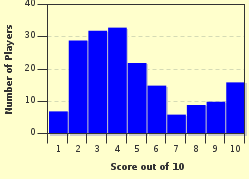Quiz Answer Key and Fun Facts
1. The outer shell of a bowling ball is referred to as a coverstock. Which of these coverstocks would create the most friction when it comes in contact on the lane?
2. Some high performance bowling balls have the MB labeled on the ball. What does MB stand for?
3. In order to find the mass bias of an unlabeled ball, what is the length you must measure from the pin to the direction of the center of gravity?
4. Which of these types of cores would typically have the highest mass bias differential?
5. In terms of reactive resin coverstocks, which of these describes a specific type of resin?
6. The United States Bowling Congress has restricted approved bowling ball manufacturers from having their balls surpass a certain differential in their cores. What is the differential the manufacturers cannot surpass?
7. Which of these grits when sanded will provide the earliest ball reaction?
8. Before 1998, the American Bowling Congress and the Women's International Bowling Congress later changed to the United States Bowling Congress, did not have any rules on a ball's core differential until this controversial ball was released, and then later banned on the Professional Bowlers Association Tour. What is the name of this ball?
9. When using a reactive resin bowling ball, the ball does something to the oil on the lane. What does it do?
10. When drilling a bowling ball, what is the grip called when the middle finger is drilled for a finger tip grip, and the ring finger is drilled for a conventional grip?
Source: Author
themonarch
This quiz was reviewed by FunTrivia editor
Nightmare before going online.
Any errors found in FunTrivia content are routinely corrected through our feedback system.

